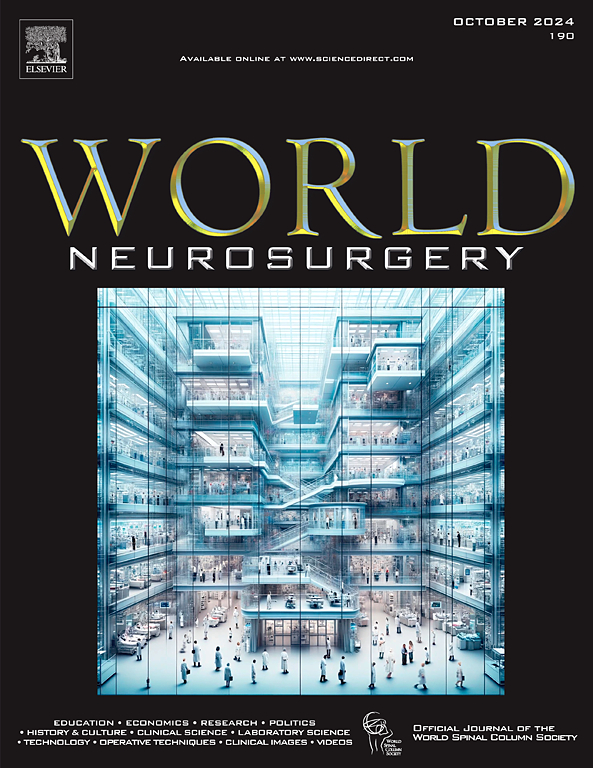Preoperative Differentiation of Spinal Schwannoma and Meningioma Using Machine Learning-Based Models: A Systematic Review and Meta-Analysis
IF 1.9
4区 医学
Q3 CLINICAL NEUROLOGY
引用次数: 0
Abstract
Background
Regarding the differences in surgical approaches for spinal schwannomas and meningiomas, preoperative differentiation of spinal schwannomas and meningiomas can be important in managing these lesions. This study evaluated the diagnostic performance of machine learning (ML)-based models in the differentiation of spinal schwannomas and meningiomas.
Methods
On December 18, 2024, a comprehensive search was conducted. The data for the best-performing model were used to calculate pooled sensitivity, specificity, area under the curve (AUC), and diagnostic odds ratio.
Results
Six studies with 644 patients were included, encompassing 364 schwannomas (59.9%) and 258 meningiomas (40.1%). Deep learning-based models (66.7%, 4/6) were the most frequent, followed by ML-based models (33.3%, 2/6). The best performance models' AUC and accuracy ranged from 0.876 to 0.998 and 0.8 to 0.982, respectively. Our findings showed a pooled sensitivity rate of 91% (95%CI: 81%–96%), a specificity rate of 92% (95%CI: 84%–96%), and a diagnostic odds ratio of 97.34 (95%CI: 23.5–403.6), concurrent with an AUC of 0.944.
Conclusions
ML-based models have a high diagnostic accuracy in preoperative differentiation of spinal schwannomas and meningiomas.
基于机器学习模型的脊髓神经鞘瘤和脑膜瘤术前鉴别:系统综述和荟萃分析。
背景:考虑到脊髓神经鞘瘤和脑膜瘤手术入路的差异,脊髓神经鞘瘤和脑膜瘤的术前鉴别对治疗这些病变很重要。本研究评估了基于ml的模型在脊髓神经鞘瘤和脑膜瘤鉴别诊断中的表现。方法:于2024年12月18日进行全面检索。最佳模型的数据用于计算合并敏感性、特异性、曲线下面积(AUC)和诊断优势比(DOR)。结果:纳入6项研究,644例患者,其中神经鞘瘤364例(59.9%),脑膜瘤258例(40.1%)。基于深度学习(DL)的模型(66.7%,4/6)最为常见,其次是基于ml的模型(33.3%,2/6)。最佳性能模型的AUC和准确度(ACC)分别为0.876 ~ 0.998和0.8 ~ 0.982。我们的研究结果显示,合并敏感性为91% (95%CI: 81%-96%),特异性为92% (95%CI: 84%-96%), DOR为97.34 (95%CI: 23.5-403.6), AUC为0.944。结论:基于ml的模型对脊髓神经鞘瘤和脑膜瘤的术前鉴别诊断准确率较高。
本文章由计算机程序翻译,如有差异,请以英文原文为准。
求助全文
约1分钟内获得全文
求助全文
来源期刊

World neurosurgery
CLINICAL NEUROLOGY-SURGERY
CiteScore
3.90
自引率
15.00%
发文量
1765
审稿时长
47 days
期刊介绍:
World Neurosurgery has an open access mirror journal World Neurosurgery: X, sharing the same aims and scope, editorial team, submission system and rigorous peer review.
The journal''s mission is to:
-To provide a first-class international forum and a 2-way conduit for dialogue that is relevant to neurosurgeons and providers who care for neurosurgery patients. The categories of the exchanged information include clinical and basic science, as well as global information that provide social, political, educational, economic, cultural or societal insights and knowledge that are of significance and relevance to worldwide neurosurgery patient care.
-To act as a primary intellectual catalyst for the stimulation of creativity, the creation of new knowledge, and the enhancement of quality neurosurgical care worldwide.
-To provide a forum for communication that enriches the lives of all neurosurgeons and their colleagues; and, in so doing, enriches the lives of their patients.
Topics to be addressed in World Neurosurgery include: EDUCATION, ECONOMICS, RESEARCH, POLITICS, HISTORY, CULTURE, CLINICAL SCIENCE, LABORATORY SCIENCE, TECHNOLOGY, OPERATIVE TECHNIQUES, CLINICAL IMAGES, VIDEOS
 求助内容:
求助内容: 应助结果提醒方式:
应助结果提醒方式:


